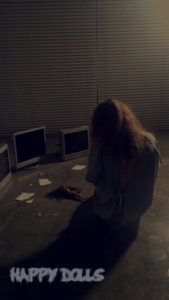Being in a teenaged girls head is a little bit like being in a lunatic asylum. Not in the sense that teenaged girls are crazy, although that may or may not be the case, but that they are always told that they are crazy and that “sanity” is right around the corner if they just try hard enough. Unfortunately for them, however, those who are driving them crazy are also telling them to be better. Girls are sold an amazing amount of mixed messages: they are beautiful just as they are but should buy make-up, creams, and serums to look better; that they should be confident but not too confident; sexy but not too sexy; that they are beautiful, that they are ugly. With all of these competing ideas scurrying around in a rapidly growing, hormonal brain, it’s no wonder that girls often turn to anorexia, bulimia, self-harm, and drugs.
 HAPPY DOLLS attempt to get inside the mental space of one of those teenaged girls. A teenaged girl, spurred by a fleeting moment of self-confidence, ask out a boy on whom she has a crush. He, however, instead crushes her dreams and expectations by mocking her with another friend. Disappointed, she wanders off, but the bullying has obviously gotten under her skin. She transfers these feelings from other onto herself in violent and abusive ways. In this case, HAPPY DOLLS speaks to ways that girls believe criticism and turn in inward, usually with vicious and detrimental results.
HAPPY DOLLS attempt to get inside the mental space of one of those teenaged girls. A teenaged girl, spurred by a fleeting moment of self-confidence, ask out a boy on whom she has a crush. He, however, instead crushes her dreams and expectations by mocking her with another friend. Disappointed, she wanders off, but the bullying has obviously gotten under her skin. She transfers these feelings from other onto herself in violent and abusive ways. In this case, HAPPY DOLLS speaks to ways that girls believe criticism and turn in inward, usually with vicious and detrimental results.
While HAPPY DOLLS does a good job in getting its point across in a very short period of time, its imagination is nonetheless bigger than its production values. The film struggles with less experienced actors and little budget, filming in a naturalistic style that doesn’t really connect to the gravity of its subject. However, what we do see here is Beltran’s strong point of view and willingness to experiment, which is what young filmmakers need to grow.
